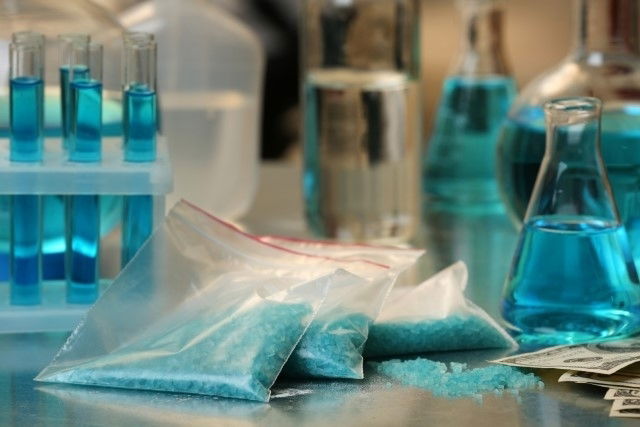What is it:
Methamphetamine is a synthetic psychoactive substance that is made from amphetamine. It causes stimulant effects on the brain and can lead to a sense of euphoria, hyper-awareness and agitation. It is usually used illegally as an illicit drug, and is produced in illegal laboratories in powder, pill or crystal form.
Methamphetamine is FDA approved for medical use with a prescription for the treatment of attention-deficit and hyperactivity disorder (ADHD) and exogenous obesity. Unfortunately, it is often used illegally as a drug of abuse, and ingested by means of swallowing, snorting, injecting or smoking.
The time of action for methamphetamine depends on the amount used and the person’s weight. Like other illicit drugs, it is highly addictive and causes toxic side effects such as psychosis, paranoid, delirium, hallucinations, brain bleeds, violent behavior, seizures and cardiac arrest, which can be life threatening.

Prescription uses
Methamphetamine is most commonly known as a street drug, however it has been FDA-approved for the treatment of two conditions: ADHD and exogenous obesity. It is sold under the brand name Desoxyn.
1) ADHD
Desoxyn can be prescribed to patients with confirmed ADHD over the age of 6 as part of a total treatment approach that involves psychological, educational and social therapy. It is not recommended for any and all patients with ADHD, but rather for those presenting with a specific set of symptoms, such as moderate to severe distractibility, apathetic mood, limited attention span, hyperactivity, apathetic mood and low impulse control.
The recommended dose is typically started at 5 mg once or twice a day, which can be increased by 5 mg on a weekly basis until therapeutic effects are achieved. The usual therapeutic dose is 20 to 25 mg, which can be given in one or two doses over a day.
2) Exogenous obesity
Exogenous obesity describes a condition in which a patient is severely overweight due to a combination of unhealthy eating practises and lack of exercise. Desoxyn can be prescribed to patients for a short-term duration (less than 3 weeks) as a complement to a calorie restriction diet, in particular to patients who have not had success with other approaches, like chronic dieting, group programs and other weight loss drugs.
The recommended dose for Desoxyn is a 5 mg taken 30 minutes before each meal. Treatment for exogenous obesity should not surpass more than 3 weeks. It should not be taken by children under 12 years of age.
How it's made
Illegal methamphetamine is fabricated in domestic laboratories (also referred to as “meth labs”. It is often made from other products that contain ephedrine or pseudoephedrine, which are substances that are commonly found in cold and flu medications.
This street drug can be found in many different forms, including a white powder or crystals, which are usually odorless and bitter in taste. It is soluble in liquids which can be inhaled, smoked, swallowed on injected. Methamphetamine can also be transformed into methamphetamine hydrochloride, also known as crystal meth, which is is smoked and causes a very serious dependency.
Side effects
Amphetamines produce many diverse effects on the body, as they increase the way neurotransmitters like serotonin, dopamine and noradrenaline work, making them more potent.
The effects of methamphetamine can be felt 5 to 30 minutes after its use, depending on the route utilized. Generally, it causes intense euphoria, extroversion, increased energy, increased libido, and reduced appetite, all which can last for 6 to 12 hours.
People who use this drug may notice hallucinations and increased overall performance in physical or cognitive tasks.
Risks associated with use
Methamphetamine is associated with health risks, both mental and physical, including:
- Memory loss
- Panic attacks
- Restlessness
- Irritability
- Aggressive behavior
- Psychosis
- Depression
- Paranoia
- Delirium
- Hallucinations
- Disorientation
- Exhaustion
- Malnutrition
- Physical and psychological dependence
- Blood vessel and brain structure damage
- Pulmonary edema
- Acute renal failure
- Liver intoxication
- Liver failure
- Brain bleeds
- Tooth breakdown
- Inner nose damage if inhaled
- Infectious diseases, infectious cellulitis or abscesses around injection sites
- Increased heart rate and blood pressure
- Heart attack or stroke
- Increased body temperature, leading to intense sweats
- Respiratory failure
Methamphetamine use can lead to tweaking, which is described as the odd behaviors, like paranoid and hallucinations, that follow frequent meth use. Often, dosing needs to be increased to achieve desired effects and reduce tweaking. The desired effects can be difficult to obtain, which can lead to more frustration, irritability, unstable behavior or violent behavior.
People who are tweaking can be observed to have rapid eye movements (up to 10 times more than normal) a shaky voice and spasmodic movements.
Methamphetamine used in high doses can lead to overdose, which causes symptoms like chest pain, intense headaches, mental confusion, difficulty breathing, fainting, loss of consciousness, seizures and coma, which can be life threatening.






























